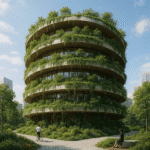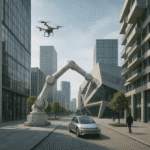Beyond conventional skylines, a new wave of architectural innovation is taking root by embracing the innate bond between humans and the natural world. This paradigm shift prioritizes designs that nourish both the urban fabric and the psyche, championing biophilic principles to shape the cities of tomorrow. By integrating organic forms, living systems, and cutting-edge materials, architects are redefining how built environments contribute to environmental sustainability and human well-being.
Conceptual Foundations of Biophilic Futurism
At the heart of this movement lies a commitment to biomimicry, the practice of emulating natural processes to solve complex design challenges. Architects draw inspiration from everything from the fractal geometry of leaves to the self-repair mechanisms of certain plants. This approach fosters buildings that are not only aesthetically harmonious but also dynamically responsive to climatic shifts.
Another core tenet is the creation of interconnected urban ecosystems. Instead of isolating structures from their surroundings, designers envision seamless transitions between indoor and outdoor spaces. Green roofs become public parks, living walls act as air purifiers, and wetlands are reimagined as stormwater management features. Such fluid boundaries enhance biodiversity while forming a resilient urban tapestry.
Technological Innovations Driving Green Design
Advances in material science and digital fabrication have propelled biophilic architecture into the realm of feasibility. Self-regulating facades equipped with photochromic glazing adapt their tint to solar intensity, reducing reliance on artificial cooling. 3D-printed building components incorporate bio-based polymers that capture carbon during production, making a case for truly carbon-neutral construction.
Robotic assembly platforms now facilitate the precise installation of complex, nature-inspired geometries. Drones guide the placement of modular green modules at height, while automated irrigation systems maintain lush vertical forests. These adaptive technologies ensure that living surfaces thrive with minimal human intervention.
Key Innovations
- Living facades with microalgae panels generating renewable energy
- Smart glass that regulates indoor temperature and lighting conditions
- Modular gardens integrated into structural elements for improved air quality
- AI-driven climate controls that forecast and adapt to weather fluctuations
- Wearable sensors enabling occupants to personalize environmental settings
Urban Integration and Community Impact
Futuristic biophilic projects extend beyond singular buildings to encompass entire districts. Mixed-use developments propose vertical farms interlaced with residential towers, fostering local regeneration of food supply and reducing transportation emissions. Public plazas host native plant nurseries and water features that double as passive cooling systems during heatwaves.
Social dynamics also transform when nature becomes an integral design partner. Educational programs embedded within living structures connect residents to ecological cycles. Community-run apiaries on rooftop gardens produce honey, teaching stewardship and yielding local produce. Such initiatives cultivate a sense of collective ownership and resilience.
- Neighborhood green corridors improving mental health and social cohesion
- Pop-up installations showcasing regenerative agriculture techniques
- Interactive water plazas that recycle greywater for irrigation
- Multi-generational community spaces shaded by retractable bio-roofs
Future Visions and Emerging Trends
Looking ahead, the convergence of biotechnology and architecture promises immersive environments that blur the line between organism and structure. Living concrete infused with calcifying bacteria could autonomously heal cracks, extending building lifespans. Programmable matter, inspired by cellular communication in forests, may enable walls to rearrange themselves in response to user needs.
Another trend gaining traction is the integration of underground biomes. Subterranean farms illuminated by spectrum-optimized LEDs produce year-round harvests, while caverns carved into bedrock provide thermally stable community hubs. These below-grade spaces alleviate surface congestion and foster new forms of spatial interaction.
Emerging Directions
- Symbiotic architecture where structures host mutualistic organisms
- Urban aquaculture systems feeding skyscraper fish farms
- Bioluminescent lighting derived from genetically enhanced microorganisms
- Dynamic shading canopies grown from fast-maturing vine species
- Networked green microhabitats tracking wildlife migration patterns
Cultivating Resilience Through Nature
As climate challenges intensify, the call for designs grounded in natural intelligence grows louder. By prioritizing resilience and regenerative capacities, architects can craft cities that not only withstand environmental stressors but flourish because of them. The integration of stormwater retention gardens, permeable pavements, and carbon-sequestering materials fortifies urban centers against rising temperatures and extreme weather.
This holistic vision transcends mere aesthetic homage to nature. It embeds living systems at every scale, from cellular materials to metropolitan networks, forging a future where the built environment and the natural world are inextricably linked. In this unfolding narrative, biophilic architecture emerges as a powerful catalyst for sustainable, human-centered, and ecologically vibrant cities.










